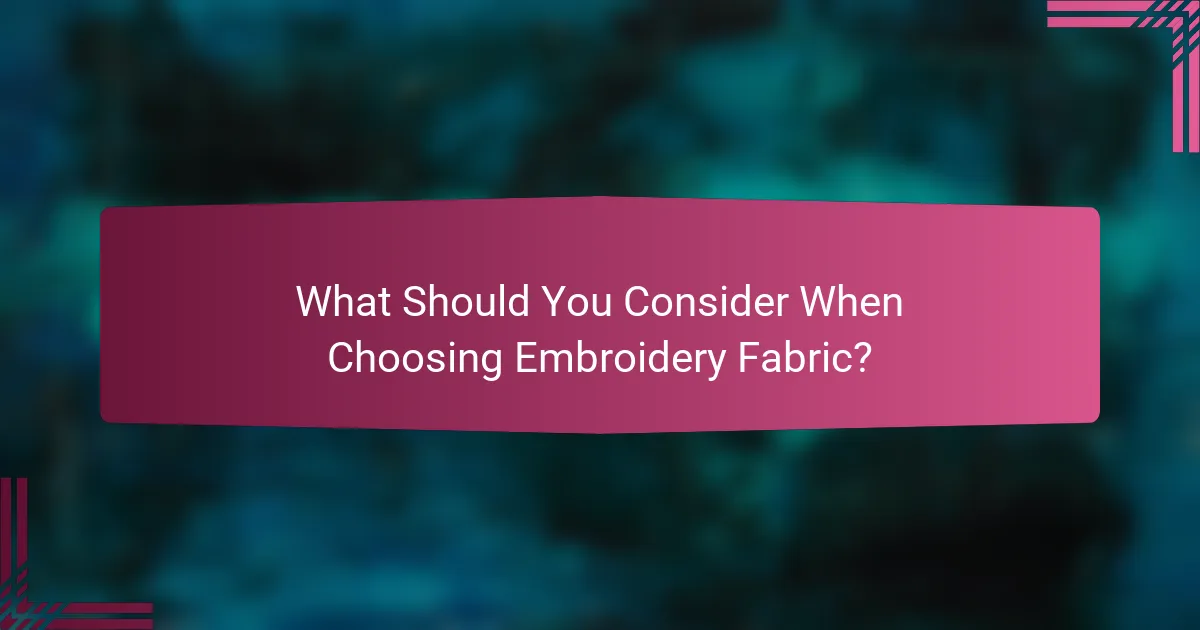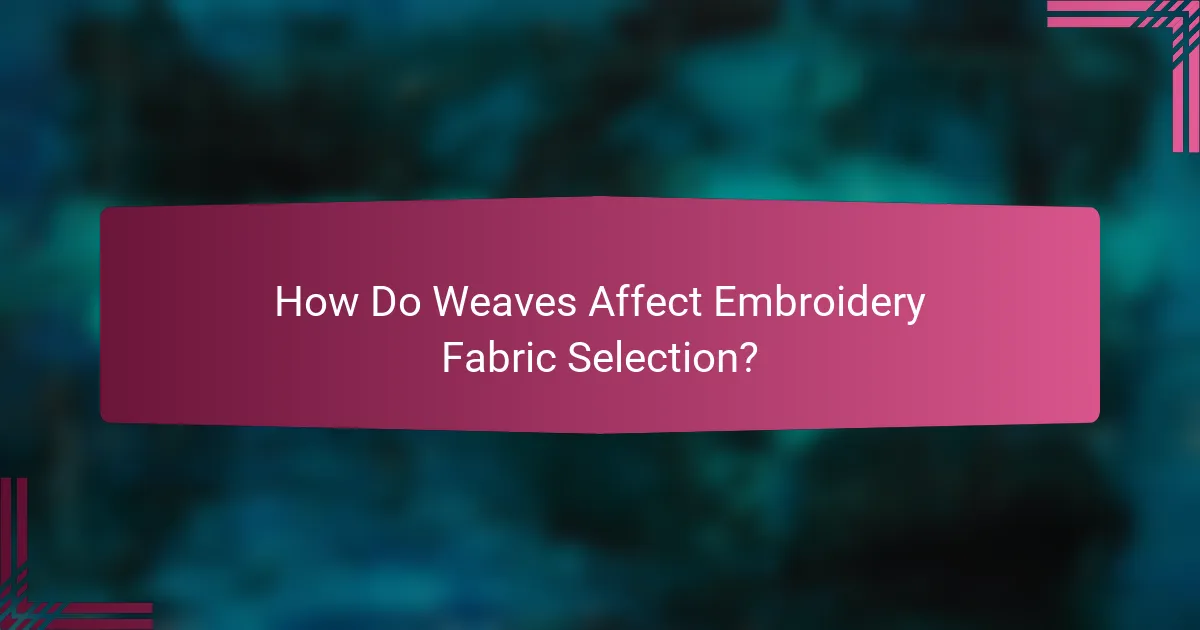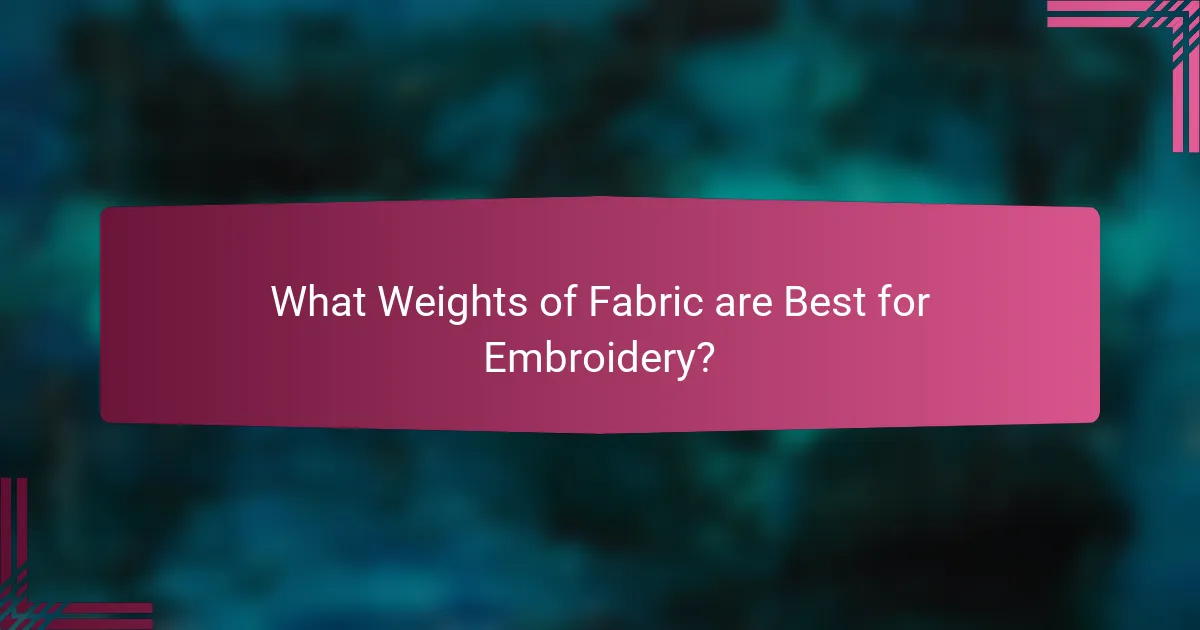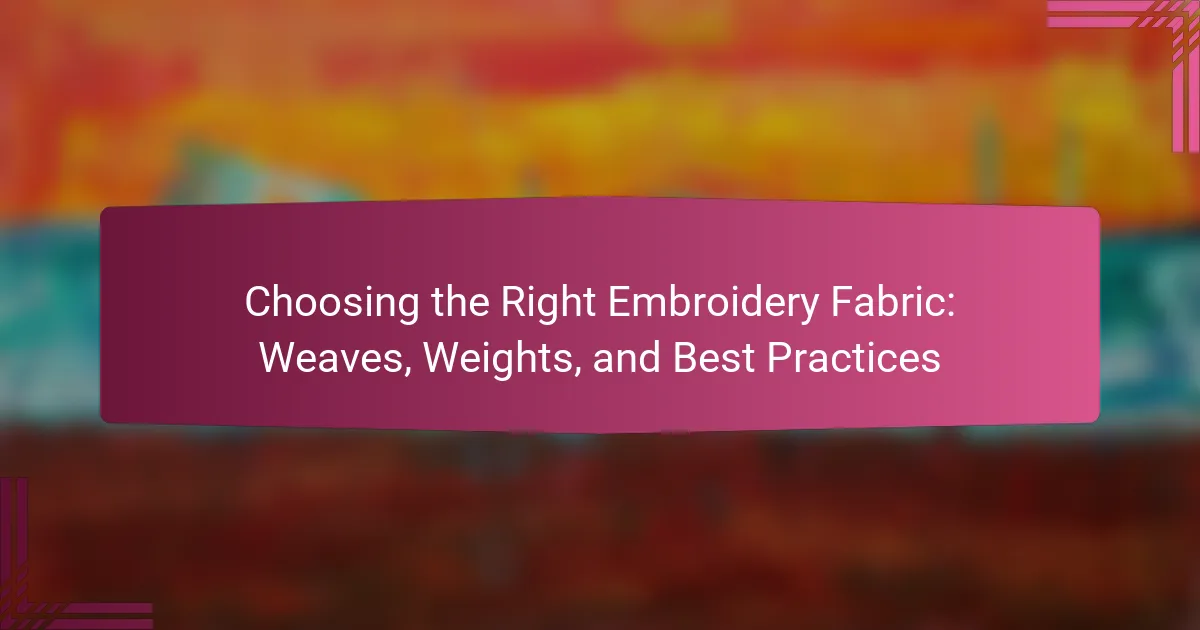
What Should You Consider When Choosing Embroidery Fabric?
When choosing embroidery fabric, consider the fabric type, weight, and weave. Different fabric types, such as cotton, linen, or polyester, affect the final appearance. The weight of the fabric influences the embroidery technique and thread choice. A lighter fabric may require stabilizers to prevent distortion. The weave impacts how well the fabric holds the embroidery. Tightly woven fabrics provide better support for detailed designs. Additionally, the fabric’s texture can affect thread visibility and overall design clarity. Choosing the right fabric ensures durability and enhances the embroidery’s aesthetic appeal.
Why is the choice of fabric important for embroidery projects?
The choice of fabric is crucial for embroidery projects because it affects the final appearance and durability of the design. Different fabrics have varying textures, weights, and thread counts. These characteristics influence how well the embroidery threads adhere and how they lay on the surface. For instance, tightly woven fabrics provide a stable base for intricate designs. Conversely, loosely woven fabrics may cause the threads to sink or distort. Additionally, the fabric’s weight impacts the tension needed during stitching. Heavier fabrics require more robust threads and different techniques to prevent puckering. According to a study by the American Embroidery Manufacturers Association, selecting the appropriate fabric can enhance the longevity of the embroidery by reducing wear and tear. Therefore, careful consideration of fabric choice is essential for achieving high-quality embroidery results.
How does fabric choice impact the final appearance of the embroidery?
Fabric choice significantly impacts the final appearance of the embroidery. Different fabrics can alter the texture, color vibrancy, and stitch definition. For example, a smooth fabric like satin allows for clean, sharp stitches, enhancing detail. In contrast, a textured fabric like canvas may obscure fine details due to its uneven surface. The weight of the fabric also plays a role; heavier fabrics can support denser designs without distortion. Additionally, fabric color influences how thread colors appear, with lighter fabrics often showcasing brighter thread shades. Therefore, selecting the right fabric is crucial for achieving the desired embroidery outcome.
What role does fabric choice play in the durability of the embroidery?
Fabric choice significantly impacts the durability of embroidery. Different fabrics have varying strengths and resistance to wear. For instance, tightly woven fabrics like canvas provide a sturdy base for embroidery, enhancing its longevity. In contrast, loosely woven materials may fray or distort over time, compromising the embroidery’s integrity.
Additionally, the fabric’s fiber content affects durability. Natural fibers, such as cotton, are generally more durable than synthetic fibers but may shrink or fade. Conversely, synthetic fabrics like polyester offer excellent color retention and resistance to shrinking.
Embroidery techniques also play a role; thicker threads may require sturdier fabrics to prevent damage. A study by the Textile Research Journal found that fabric choice can reduce embroidery wear by up to 30%. Thus, selecting the right fabric is crucial for maintaining embroidery quality over time.
What are the different types of embroidery fabric?
The different types of embroidery fabric include cotton, linen, silk, polyester, and canvas. Cotton fabric is popular for its versatility and ease of use. Linen is known for its strength and natural texture. Silk offers a luxurious finish and a smooth surface for detailed work. Polyester is durable and resistant to wrinkles, making it suitable for various projects. Canvas is heavy-duty and ideal for larger pieces or outdoor projects. Each fabric type has unique properties that affect the embroidery outcome.
What are the most common fabric types used in embroidery?
The most common fabric types used in embroidery are cotton, linen, polyester, and silk. Cotton is popular due to its durability and versatility. Linen offers a natural texture and is often used for high-quality projects. Polyester is favored for its strength and resistance to wrinkles. Silk provides a luxurious finish and is ideal for delicate designs. These fabrics are widely used in the embroidery industry, ensuring quality and aesthetic appeal in various applications.
How do different fabrics affect the embroidery technique used?
Different fabrics significantly affect the embroidery technique used. The texture and weight of the fabric determine the type of needle and thread required. For example, lightweight fabrics like silk necessitate finer needles and threads. Heavier fabrics such as canvas require thicker needles and stronger threads. Additionally, the weave of the fabric influences the stitch type. Fabrics with a loose weave may need stabilizers to prevent distortion. Conversely, tightly woven fabrics can hold intricate designs better without additional support. The fabric’s stretchability also impacts technique; knit fabrics require special care to avoid puckering. Overall, selecting the appropriate fabric is crucial for achieving quality embroidery results.

How Do Weaves Affect Embroidery Fabric Selection?
Weaves significantly influence embroidery fabric selection. Different weaves affect the texture, durability, and appearance of the fabric. For example, a tight weave provides a smooth surface, ideal for detailed embroidery. Conversely, a loose weave may result in uneven stitching and poor definition. Fabrics like canvas have a heavier weave, suitable for robust designs, while lightweight weaves like muslin work well for intricate patterns. The choice of weave also impacts thread tension and needle selection. Therefore, understanding weaves is crucial for achieving the desired embroidery outcome.
What are the various weaves available for embroidery fabrics?
The various weaves available for embroidery fabrics include plain weave, twill weave, satin weave, and canvas weave. Plain weave is characterized by a simple over-and-under pattern, providing a flat surface. Twill weave features a diagonal pattern, adding texture and durability. Satin weave has a smooth surface with a high sheen, ideal for detailed embroidery. Canvas weave is sturdy and often used for heavier applications. Each weave type offers unique qualities that affect embroidery results.
How does the weave type influence the texture of the finished product?
The weave type significantly influences the texture of the finished product. Different weaves create varying surface characteristics. For instance, a plain weave results in a smooth texture, while a twill weave produces a diagonal pattern that adds depth. Satin weaves yield a glossy finish, enhancing the tactile experience. The density of the weave also affects softness and drape. Tight weaves typically create a firmer texture, while looser weaves allow for more fluidity. The choice of weave can thus dictate both the visual appeal and functionality of the fabric.
What are the advantages and disadvantages of different weaves?
Different weaves have specific advantages and disadvantages affecting their suitability for embroidery. Plain weaves are strong and versatile, making them ideal for various projects. However, they may lack texture and depth. Twill weaves offer a diagonal pattern, providing durability and a unique appearance. Their downside is that they can be more challenging to embroider due to the texture. Satin weaves have a smooth surface, allowing for vibrant embroidery designs. The disadvantage is that they can fray easily and may require special handling. Each weave type impacts the final look and functionality of the embroidered piece, influencing the choice of fabric based on project needs.
How can you identify the right weave for your project?
To identify the right weave for your project, assess the fabric’s texture and structure. Different weaves, such as plain, twill, and satin, affect the final appearance and durability. Consider the project requirements, like stitch type and thread thickness. For example, a tightly woven fabric is ideal for detailed embroidery. Additionally, evaluate how the weave interacts with the thread. Some weaves may cause thread to snag or slip. Testing a small sample can provide insights into how the weave performs. Ultimately, the right weave enhances the project’s quality and longevity.
What factors should you consider when selecting a weave for your design?
When selecting a weave for your design, consider the fabric’s texture, weight, and drape. The texture affects how the embroidery appears on the surface. A heavier weave provides stability, while lighter weaves allow for more flow and movement. Drape influences how the fabric hangs and interacts with the design. Additionally, the intended use of the fabric, such as for garments or decorations, impacts the choice of weave. Different weaves, like plain, twill, or satin, offer unique visual effects and durability. Each weave type can enhance or detract from the overall design aesthetic.
How does the intended use of the embroidered item affect weave choice?
The intended use of the embroidered item significantly influences the choice of weave. Different weaves provide varying levels of durability, texture, and drape. For items like apparel, a softer weave is often preferred for comfort. In contrast, home décor items may require sturdier weaves to withstand wear. Additionally, functional items like bags benefit from tightly woven fabrics for added strength. The aesthetic appeal is also a factor; decorative pieces might use more intricate weaves to enhance visual interest. Ultimately, the specific application dictates the weave selection to ensure the final product meets both functional and aesthetic requirements.

What Weights of Fabric are Best for Embroidery?
The best weights of fabric for embroidery typically range from 2 to 8 ounces per square yard. Fabrics within this range provide a balance between stability and flexibility. Lightweight fabrics, around 2 to 4 ounces, work well for delicate embroidery designs. Medium-weight fabrics, approximately 5 to 6 ounces, are versatile for a variety of embroidery techniques. Heavier fabrics, around 7 to 8 ounces, are suitable for bold designs and can handle intricate stitching. The choice of fabric weight affects the overall appearance and durability of the embroidery.
What are the different fabric weights and how do they impact embroidery?
Fabric weights are categorized into lightweight, medium weight, and heavyweight. Lightweight fabrics, such as chiffon or organza, are delicate and may require stabilizers for embroidery. Medium weight fabrics, like cotton or linen, provide a balance that supports detailed designs without excessive distortion. Heavyweight fabrics, such as canvas or denim, can handle dense embroidery but may require specialized needles and thread to prevent breakage. The choice of fabric weight directly affects the embroidery’s appearance and durability. Lighter fabrics may result in less defined designs, while heavier fabrics can support intricate patterns. Ultimately, selecting the appropriate fabric weight is crucial for achieving the desired embroidery quality.
How does fabric weight affect the type of embroidery thread used?
Fabric weight influences the choice of embroidery thread by determining its thickness and strength. Heavier fabrics require thicker threads for proper tension and visibility. Lightweight fabrics, on the other hand, are best suited for finer threads to avoid puckering. The thread must also match the fabric’s weave to ensure even stitching. For instance, a canvas fabric works well with polyester threads due to their durability. Conversely, delicate fabrics like silk benefit from using rayon threads that are softer and more flexible. This matching prevents thread breakage and maintains the integrity of the design.
What weight is recommended for specific embroidery techniques?
For embroidery techniques, the recommended weight varies by method. Generally, a weight of 40 wt is ideal for most machine embroidery. This weight provides a balance of strength and detail. For fine details or delicate designs, a lighter weight of 60 wt is preferable. This allows for more intricate stitching without overwhelming the fabric. Conversely, for heavy fabrics or bold designs, a heavier weight of 30 wt is suitable. This ensures visibility and durability in the final product. These weight recommendations are based on industry standards and practices.
How do you determine the right fabric weight for your project?
To determine the right fabric weight for your project, consider the intended use of the fabric. Fabric weight is measured in grams per square meter (GSM). Lighter fabrics, around 100-200 GSM, are suitable for delicate garments or linings. Medium-weight fabrics, between 200-300 GSM, work well for everyday clothing and quilting. Heavier fabrics, over 300 GSM, are ideal for outerwear and upholstery.
Assess the type of embroidery you plan to use. Heavier fabrics may require stabilizers for support. Additionally, consider the drape and structure needed for your design. Fabrics with a crisp finish hold shapes better, while softer fabrics drape more fluidly.
Test fabric samples to compare weights and textures. This hands-on approach allows you to visualize how the fabric will perform in your project. Ultimately, the right weight balances durability, drape, and the specific requirements of your embroidery technique.
What considerations should you keep in mind regarding fabric weight and design complexity?
Fabric weight significantly impacts design complexity. Heavier fabrics can support intricate designs better than lighter ones. Lighter fabrics may distort under complex stitching, leading to uneven results. Design complexity also influences fabric choice; detailed patterns require stable materials. Stability in fabric helps maintain the integrity of the design. For example, denim can handle complex embroidery due to its weight. In contrast, silk may not support heavy designs well. Choosing the right fabric weight ensures the design’s clarity and durability.
How does the weight of the fabric influence the overall feel of the finished piece?
The weight of the fabric significantly influences the overall feel of the finished piece. Heavier fabrics tend to provide a more substantial and luxurious feel. This weight can enhance the drape and structure of the item. Lighter fabrics often result in a more delicate and airy sensation. The choice of fabric weight can affect the embroidery’s visibility and texture. For example, dense embroidery may require a heavier fabric to support the design. Conversely, lighter fabrics may require careful handling to avoid puckering. Overall, fabric weight plays a crucial role in the tactile experience of the final product.

What Best Practices Should You Follow When Choosing Embroidery Fabric?
When choosing embroidery fabric, consider the fabric’s weight and weave. Lightweight fabrics are suitable for detailed designs. Heavier fabrics can support larger, bolder embroidery. Additionally, select a fabric that matches the thread type. Cotton threads work well with cotton fabrics. Polyester threads are versatile and can be used on various fabrics. Test the fabric with a sample stitch to check for compatibility. Ensure the fabric is pre-washed to prevent shrinkage. Lastly, consider the fabric’s texture, as smoother surfaces yield cleaner stitches.
What are the essential tips for selecting embroidery fabric?
Select embroidery fabric based on its weave, weight, and compatibility with your design. Fabrics like cotton and linen are popular for their durability and ease of use. Consider the fabric’s weight; lighter fabrics work well for detailed designs, while heavier fabrics are suitable for bold patterns. Ensure the fabric is pre-washed to prevent shrinkage. Test a small piece of fabric with your selected thread and design to check compatibility. Use stabilizers to support the fabric during embroidery. These tips enhance the quality and longevity of your embroidery projects.
How can pre-washing fabric improve your embroidery results?
Pre-washing fabric improves embroidery results by removing sizing and contaminants. Sizing can create a barrier that affects thread tension and needle [censured]. Contaminants may cause discoloration or uneven stitching during the embroidery process. Additionally, pre-washing helps to preshrink the fabric. This prevents future shrinkage that could distort the embroidery design. Fabrics that are not pre-washed may pucker or warp after washing. Overall, pre-washing ensures a smoother, more stable surface for embroidery.
What tools can assist in selecting the right fabric for your embroidery project?
Fabric selection tools for embroidery projects include fabric swatch books, online fabric calculators, and embroidery software. Fabric swatch books provide samples of various materials. They help in visualizing texture and color. Online fabric calculators assist in determining the appropriate fabric weight for designs. These calculators account for stitch density and design complexity. Embroidery software can simulate designs on different fabrics. This allows for a preview of the final product. Each of these tools enhances the decision-making process. They ensure that the chosen fabric aligns with the project requirements.
How can you troubleshoot common fabric-related issues in embroidery?
To troubleshoot common fabric-related issues in embroidery, first identify the specific problem. For puckering, ensure the fabric is properly hooped without tension. If thread breaks occur, check for the correct needle size and type for the fabric. For needle marks, use a stabilizer appropriate for the fabric weight. If the design shifts, verify the fabric is securely hooped and not overly stretched. For uneven stitches, adjust the machine tension settings. If fabric fraying happens, consider using a stabilizer or a different needle. Each of these solutions addresses common issues, ensuring better embroidery results.
What steps can you take to fix puckering or distortion in embroidery?
To fix puckering or distortion in embroidery, start by ensuring proper tension on the embroidery machine. Adjust the upper and lower thread tension as needed. Next, use a stabilizer appropriate for the fabric type to support the stitches. Choose a stabilizer that matches the weight of the fabric to prevent movement. Additionally, consider using a larger needle size for thicker fabrics to reduce stress on the material. Another step is to hoop the fabric securely, avoiding any slack that could lead to distortion. Finally, test the embroidery on a scrap piece before working on the final project to ensure settings are correct.
How can you avoid fabric fraying during the embroidery process?
To avoid fabric fraying during the embroidery process, use a stabilizer. Stabilizers provide support for the fabric and prevent movement. They come in various types, such as tear-away, cut-away, and wash-away. Choose the right stabilizer based on your fabric type and embroidery design. Additionally, using a sharp needle can minimize fraying. A needle designed for embroidery creates cleaner holes in the fabric. Finally, consider finishing the edges of the fabric with a zigzag stitch or serger. This technique can significantly reduce fraying before starting the embroidery.
Choosing the right embroidery fabric is essential for achieving high-quality results, as it directly impacts the appearance, durability, and technique used in embroidery projects. Key factors to consider include fabric type, weight, weave, and texture, each influencing the final design and its longevity. The article explores various fabric types such as cotton, linen, silk, and polyester, along with their respective attributes and best practices for selection. Additionally, it addresses how different weaves affect texture and design complexity, while providing troubleshooting tips for common fabric-related issues in embroidery.
